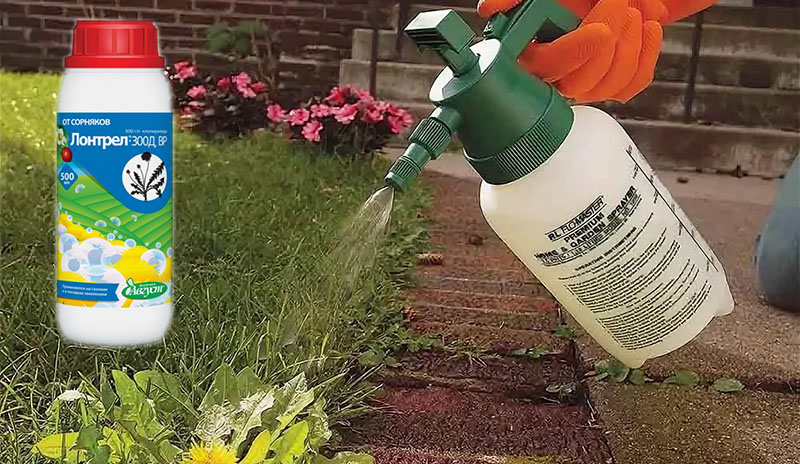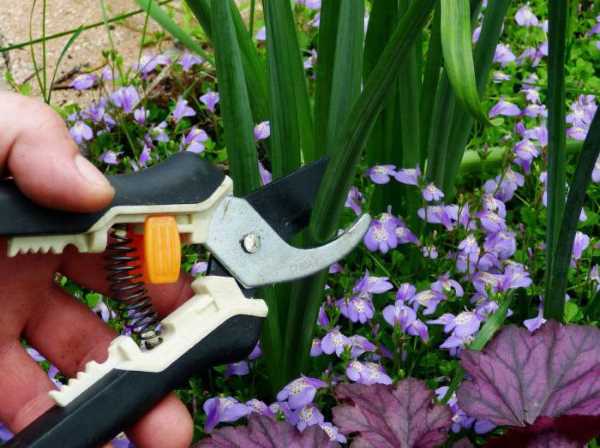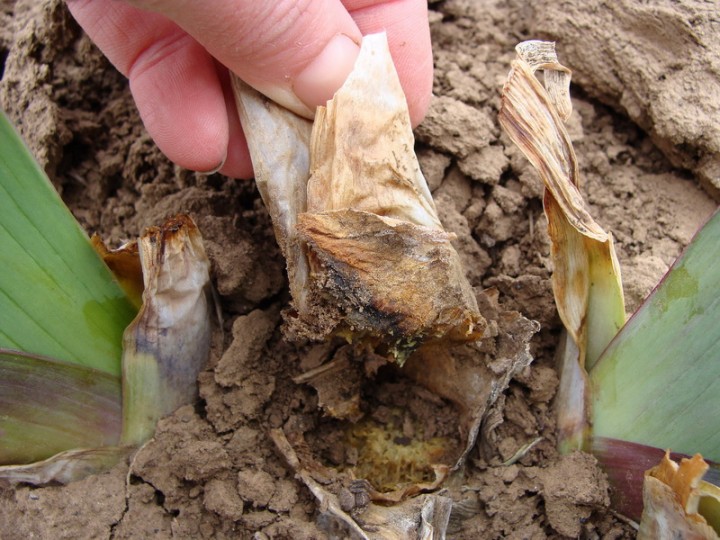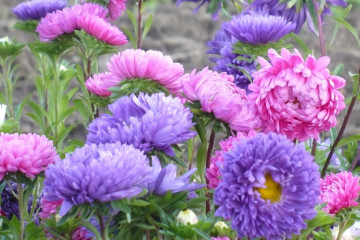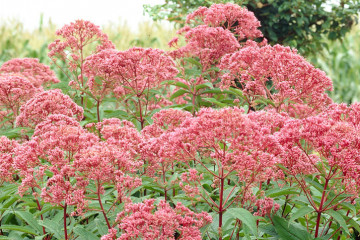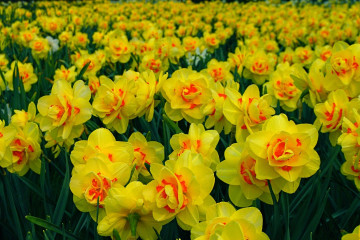Irises - planting and care in the open field
Content:
Many growers prefer to grow irises in their flower beds. And this is not surprising, because they symbolize joy. According to legend, when Prometheus gave people fire, nature itself rejoiced, a rainbow even appeared in the sky. It was visible all day, and in the morning, when people woke up, irises were found in its place. Now these flowers can decorate any area. To do this, you just need to know how to plant and care for irises.
Irises: planting and care in the open field
How, when and where to plant irises? This is one of the most interesting topics for avid summer residents who are used to seeing their site beautiful and well-groomed. After planting, these plants do not like the cold, so young seedlings should have time for them to get stronger before the onset of frost. They are destructively affected by temperatures of -10 ° C and below.
During planting, you also need to consider the following factors:
- Plants are best planted in the morning.
- It should be warm days outside.
- It is imperative to exclude drafts and wind.
High varieties of irises are planted at a distance of about 70 cm, and dwarf ones at least 30 cm.
Since bearded irises do not like stagnant water, they must be placed in drained soil. If this is not possible, flowers are planted on small elevations from which water flows well. The place should be well lit, plants do not bloom well in the shade. However, it is allowed that in the afternoon the flowers are in partial shade.
Some growers also sift the soil through small cells. You can simply use Lontrel or Lintour herbicides, which are successful in killing weeds. After using them, all that remains is to collect the roots of the weeds.
Prepare the soil in at least 3 weeks. Although iris flowers are picky, but if we are talking about exquisite types of plants, then it is better to prepare the soil yourself. A nutritious soil will give your plants the opportunity to bloom luxuriantly.
To prepare useful soil you will need:
- compost;
- garden land;
- phosphorus-potassium fertilizers;
- wood ash or dolomite flour, which are used to deoxidize the soil.
If the soil is clay, sand must be added to it and vice versa, if it is sandy, then clay is added to it. For disinfection purposes, the soil must be treated with Baikal or Fitosporin-M.
Planting irises in summer
Summer is an ideal period for transplanting plants, since during this period new rhizome shoots are just emerging, and their active growth will begin about 2 weeks after transplanting.
By the time the flower bud appears, the males will have time to take root.
Planting irises in autumn
In autumn, specimens reproduce well in which the bud is already laid and its length has reached 6 cm, and its diameter is 3 cm.At this moment, the root system of the irises should have a well-formed root system and if prolonged rains do not begin, then by next year the plant will get stronger and give excellent flowers ...
Planting irises in spring
Spring planting of irises begins at the end of March and lasts until May inclusive.It all depends on the climatic conditions.
Before planting, you need to inspect the rhizome well. It is necessary to cut out damaged and rotten places, as well as disinfect the roots in a solution of potassium permanganate and treat them with a growth stimulant, for example, Ecogel or Zircon are suitable.
If the sprouts are purchased on the market, then they even need to be kept for some time in a disinfectant, because who knows in what conditions they were stored.
Planting bulbous irises
Bulbous species must be planted in late summer or early September, so that before the first frost they have time to take root and get stronger. In the southern regions, planting can be carried out in October.
If there is a need to plant the bulbs in the spring, you need to simulate a cold snap, then this year you will be able to enjoy the flowers that have appeared. For this, the bulbs in a container or in a pot are placed on the balcony or in the refrigerator. You just need to make sure that the shoots are directed straight up. Seedlings are planted in the ground already in April or May.
Step-by-step planting process
To grow plants from a bulb, you need to read the information on planting and caring for irises. To do this, adhere to the following recommendations:
- You need to choose the right place for landing.
- Prepare the soil and knock out holes.
- The depth of the planting hole should not exceed 8 cm. The same distance is maintained between the bulbs.
- The planting material is laid out on the bottom of the hole and pressed a little, and then sprinkled with soil.
- After planting, the plants are watered.
- At the last stage, the soil is mulched with peat.
Growing irises from seeds
You can grow cockerels from seeds both in September and in March. However, if the frosts are late, then before they occur, the sprouts will have time to appear, and they will simply freeze.
The best time to do seeds is in February. To do this, they are wrapped in a damp cloth and placed in a container with a lid under the freezer. There the seeds are stored for 30 days at a temperature of about 3 ° C.
How to care for irises in the garden
Males are picky plants. Therefore, caring for them is very simple.
The main thing is to periodically pull out the weeds. This must be done by hand, as in males the root system is close to the surface and can be damaged. Despite this, you still have to occasionally loosen the soil carefully - this is necessary for better air circulation.
Dry flowers that have fallen to the ground should be collected periodically, as they attract pests. You should also ensure proper watering, feeding and treat the plants with pests and diseases.
Watering mode
Until the flower buds form and bloom, they need to be watered twice a week. Further, throughout the summer, the soil is watered only when it is completely dry, if we are not talking about the Siberian and marsh varieties. These plants love moisture.
After the end of the flowering period, the irises should temporarily stay in dry soil.
How to feed irises in spring for lush flowering in the garden
The first spring nitrogen fertilization is carried out when the snow has completely melted and the earth dries out. This happens depending on the climatic conditions from the end of February to mid-April.
The second feeding is carried out when the irises begin to grow buds. During this period, they need phosphorus-potassium feeding. Both of these nutrients are found in Agrofosk.
Phosphorus is also found in bone meal products. However, such a substance is hardly absorbed from the surface, so you need to make small grooves around the irises and fill them with this fertilizer.
Potassium fertilization is carried out using fertilizers such as sylvinite, furnace ash and potassium sulfate.
Potassium sulfate and sylvinite are introduced into the soil at the rate of one and a half tablespoons per 1 m². Ash is scattered around the plant in the amount of 3 tablespoons per bush.
During the flowering period, males need fertilization with potassium and phosphorus. It is necessary to apply dressings only in liquid form, otherwise the roots may suffer from burns.
Preparing for winter
In order for the flowers to endure the winter well, they need to be properly looked after even from the moment of planting:
- Plants are planted on a hill so that in winter there is no stagnant water near them.
- After the end of the flowering period, the bulbs should be in dry soil and dry well.
- It is necessary to dig them out only when all the leaves of the plant are dry. The bulbs are placed in a cardboard box, each individually wrapped in a cloth, and sprinkled with peat. The box is placed on the balcony, or in another cool place.
- You can leave the bulbs in the ground for the winter, but cover them with dry leaves to protect them from frost.
When to replant irises after flowering
When can irises be propagated after flowering? This question is of interest to many gardeners. As soon as the males have faded and young links are formed on their roots, but the buds have not yet appeared, they are ready for transplantation. Annual shoots can be transplanted when they reach 3 cm. With young roots, you need to be as careful as possible, because they are very fragile.
How to plant irises correctly
When it is already known to plant irises, now it is necessary to get acquainted with the basic rules of reproduction:
- You need to divide the bush with a pitchfork. After it is dug up, the remains of the earth are removed from the roots.
- Dry leaves are removed, and the roots are cut off, leaving about 10 cm. The leaves are also cut off. Only 15 cm should remain.
- The mother bush is divided into parts, and a weak layer is dipped in a solution of potassium permanganate.
- The cut site is treated with activated carbon with the addition of sulfur.
- After the roots have dried out a little in the sun, they are treated with a growth stimulant.
- Then the shoots are planted in the ground in the usual way.
Iris diseases
Most often, bettas are susceptible to:
- Bacterial rot. The causative agents of this disease hibernate in the soil or on plant debris. Bacterial rot appears when the snow melts or after flowering. The reason for the appearance is an excess of nitrogen in the soil, as well as a dense planting and dampness. First, the base of the leaves becomes soft, and then the entire leaf turns yellow and dries out. In the second stage, bacterial rot affects the entire fan and penetrates the root. A very unpleasant odor is produced. Many growers prefer to destroy the plant than to start a long and not always successful treatment. However, there are cases when the antibiotic Doxycycline was applied to problem areas and the plant revived.
- Fusarium. Too much humidity becomes its cause. First, gray spots appear on the leaves, then the rhizome rots and dries out. To avoid infection, you need to follow the rules for caring for males and avoid mechanical damage. The affected plant is eliminated, and the place where it grew is treated with copper oxychloride. For the rest of the plants, Vitaros or Topsin-M are used.
- Leaf spot. Dense plantings, high humidity and lack of phosphorus lead to this disease.The disease mainly manifests itself in the second half of June until the end of July. In the fight against leaf spot, drugs such as Strobi or Ordan are used.
Why irises don't bloom
If irises are improperly taken care of, then they may not bloom. So why don't irises bloom? There are several reasons for this. The main ones include:
- Incorrect fit.
- Lack of space. After 5 years, the plants grow so much that they must be planted.
- Lack of light - in this case, transplanting irises becomes a necessity.
- No pest control.
- Bad soil that is not at all suitable for these species.
- Failure to comply with wintering rules.

